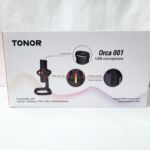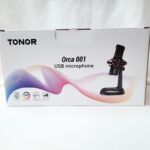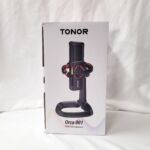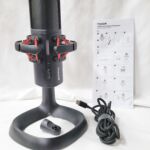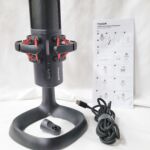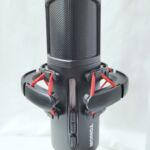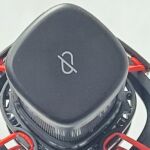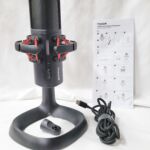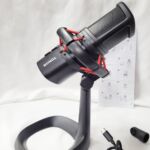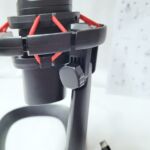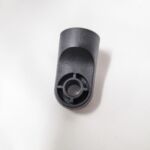Tonor Orca 001
disclaimer: I was recently asked to review the Tonor Orca 001 microphone and while microphones have not been a big part of the blog, I find myself using them on an ever more frequent basis between meetings for work, game play, podcasting, and visiting with family. Tonor was kind enough to send the Orca 001 retail kit for review. I have no financial interest in Tonor or any of its distributors. For more information on Tonor products, see their website, or their Amazon store.
Unboxing / Packaging:
The mic comes well packed in foam already mounted to the stand so is ready to go with almost no work whatsoever. A USB type-C to type-C cable is provided with a Type-A adapter at one end for use with older computers or consoles and with the mic being plug and play, grabbing the mic and cable may be all you need. There is also an instruction sheet and an arm adapter should you wish to put the mic on a standard arm instead of using the provided base.
Mic Build:
The body is largely aluminum in a matte black finish with a two plastic pieces where the shock mount attaches and even those plastic components are held in place by screws rather than just being glued in place. The mic body is more or less square with rounded edges and mounts with one edge toward the front to give a more stylized look. That same front edge houses the LED light, “volume buttons” (more on this in a minute) and, the Noise cancelling button. Sloped top and bottom surfaces add to the style of the design as well as being functional with a capacitive mute button on the top and the USB type-C port and 3.5mm headphone jack at bottom.
Stand / mount Build:
The Orca’s stand is well built and offers a solid mounting platform with good weight to resist movement and felt padding on the bottom to prevent scratching of surfaces. The base of the stand has a cutout to allow cable passage beneath the stand for a cleaner looks as well. The shock mount is attached to the screw via an adjustment screw and allows rotation of the mic from just beyond vertical to just past horizontal if desired. The addition of the shock mount is a nice touch and something not usually seen at this price point but it is rather small so don’t expect miracles here. I did find that tapping the table was clearly audible despite the shock mount and depending on the tilt, the mic at times does contact the stand. Replacing the stand with an arm does help eliminate the issue and with the provided adapter the Orca is ready to be arm mounted out of the box. Tonor offers the T30 boom arm that fits the Orca 001 and is a good quality arm should you need one for your desk or studio.
Specs/Controls:
The Orca is a cardioid condenser microphone with a sampling rate of 48kHz, a frequency response of 50Hz-16kHz and a sensitivity of -38dB – +3dB. Nominal output impedance is 2.2kΩ and signal to noise ratio is listed as 95dbB. What this means to the user is the mic is designed to be used by a single person sitting in front of the mic and despite the rear grill over the capsule, the cardioid design means the mic pics up very little behind it. Podcasters with guests will want a bi-directional or omni-directional mic like the Tonor G11 if you need to pickup voices around the table.
The controls are very simple and straight forward with a touch mute/unmute at top, and the “volume” up/down and noise-cancelling on the lead edge below the LED. Here I do have a couple of gripes. First, the buttons are audible if used during a recording and while the LED light may look more at home in a gaming setup, a gain knob would be easier to understand than blue is low sensitivity and red is high so what is green again? This brings up the next point, the “volume” controls are not volume controls at all, but are instead gain controls for the mic itself. With the 3.5mm jack for headphones, one would be excused for thinking the volume buttons would adjust the headphone volume but for that you need the source device (computer/console).
Speaking of which, the mic is plug and play with no drivers needed for Windows, Linux, Mac, and PS4. Unfortunately, Xbox does not have native support for USB mics so, no surprise that it did not work with the Xbox.
Sound:
To test the sound quality of the Orca, I used it as my microphone for all my activities for a week, podcast, office meetings, gaming, the works. I found it worked quite well for the most part as long as I kept my face in front of the mic and the distance between about 10-18 inches between. If I got close to the mic, I started to get plosive sounds and sibilance. If I backed away too much, levels dropped out. For those who need use this mic at a distance of less than about 10 inches, a pop filter of some form will definitely help as I found reducing the sensitivity tended to mean more background noise came through along with the vocal. For that reason, it was best to keep the gain higher, but use some form of pop filter when seated close to the mic.
Once I learned the needed gain setting and adjusted to yellow (see what I mean about -12dB would be more informative?) the mic did a good job of capturing my vocals for a recording with good weight in the lows which is something a lot of mics lack, as well as the normal mids and highs that most mics are capable of doing well. There was some background noise that was picked up, but not unacceptably so.
The noise cancelling option is super aggressive and while it gets rid of most noises, I found it also tended to clip the beginning and end of sentences when I was trying to record in an already fairly quiet environment. It is useful if working in a very loud environment, but when used for podcast recording, one if better off to go somewhere quiet where they don’t have to rely on the noise cancelling function.
The real-time monitoring via the headphone port worked well, but didn’t always echo noise-cancelling to my ear so I didn’t hear the cutoff at the beginning of the sentence until I went back and re-listened to the recorded session. This may be caused by the natural side-tone one has when speaking masking over the cut being echoed to the headphones.
Thoughts/Conclusions:
With work, gaming, podcasts, and family zoom meetings, I get plenty of time to use a microphone these days as do many others. We may not have ever been interested in broadcast or studio technology before but with the changes to multi-player gaming and with the work from home movement, more people than ever have need of a solid microphone for their computer systems. I found the Tonor Orca 01 to offer very good performance with solid ergonomics and easy mute and ANC controls. Its probably best for gaming and home office use where the gain can be set and forgotten as the LED while cool is less informative than a dial indicator and a bit less easy to return to an exact level every time for something like podcasting. Setting the gain can be done precisely by watching the level in an application, but that takes an extra step and slows the process compared to a dial on the mic itself. The ANC does a good job of filtering out a lot of background noise and with the cardioid design it naturally excludes noise from most directions anyway. This again is a blessing to most but be aware that the Orca 01 is not a universal mic so those sitting behind it are not likely to be heard. For those who want even better isolation, Tonor makes an arm that eliminates vibrations from a desktop when using the provided stand and the Orca 01 comes with an adapter to arm mount it. If noise is a critical consideration I’d recommend using an Arm and I also find it easier to position the mic at proper distance from the face without having to bend toward the desk unnaturally. Some form of pop filter would be a good addition as the mic does suffer from some plosive sounds when gain is high or the speaker is too close and this can easily be corrected with either a slip over or pancake style pop filter between the user and mic.
The caveats listed above are certainly not unique to the Orca 01 and most microphones have some degree of vibration picked up when used with a desk mount and more than a little plosive sound when too close to the mic so these shouldn’t be thought of as reasons not to purchase the Orca01. It offers a very good value at <$80 (shop around a bit) and performs at a level very close to models I’ve tested costing quite a bit more. For those looking for a higher performance mic than the average boom mic on a headphone or those looking to get into podcasting without spending a fortune, the Tonor Orca 01 deserves more than a passing glance. It is one of the best sub-$100 mics I’ve had the pleasure of using.


